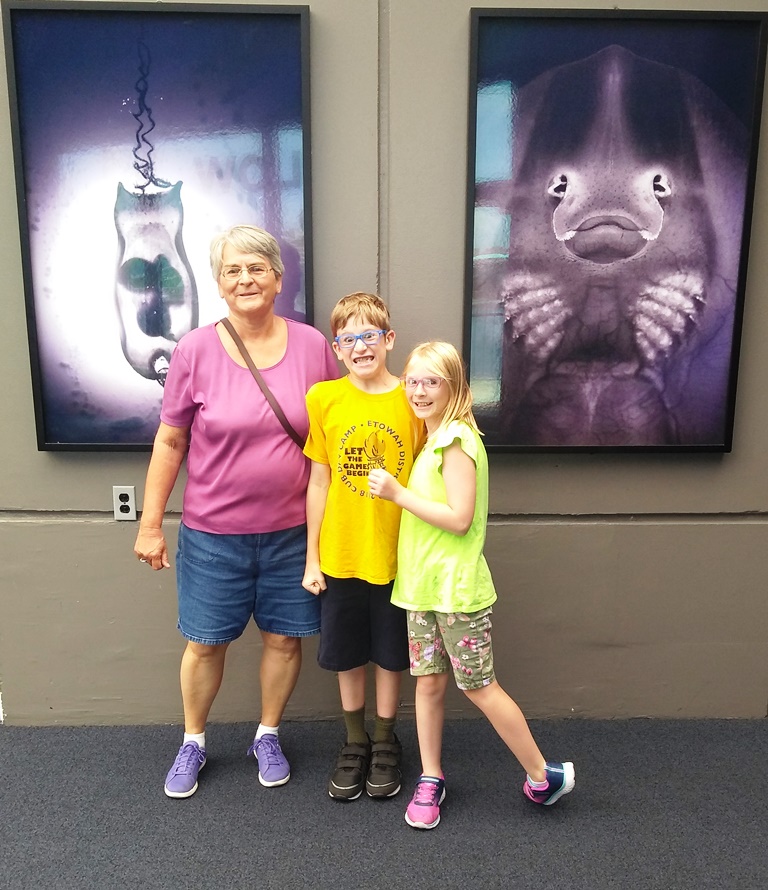
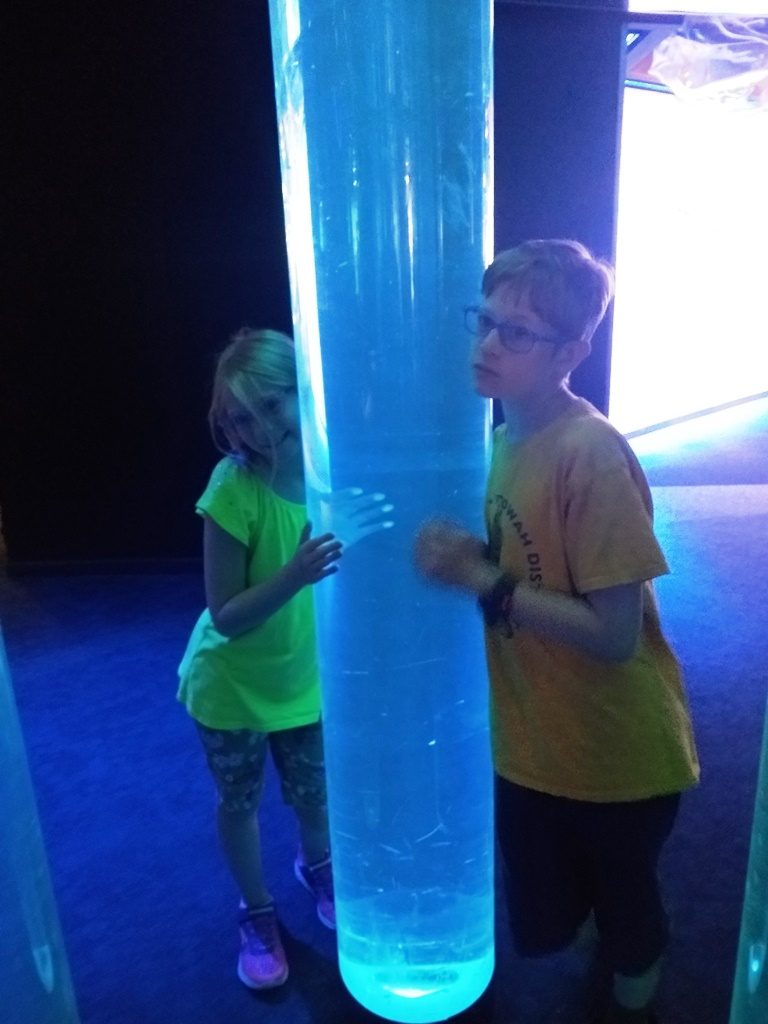
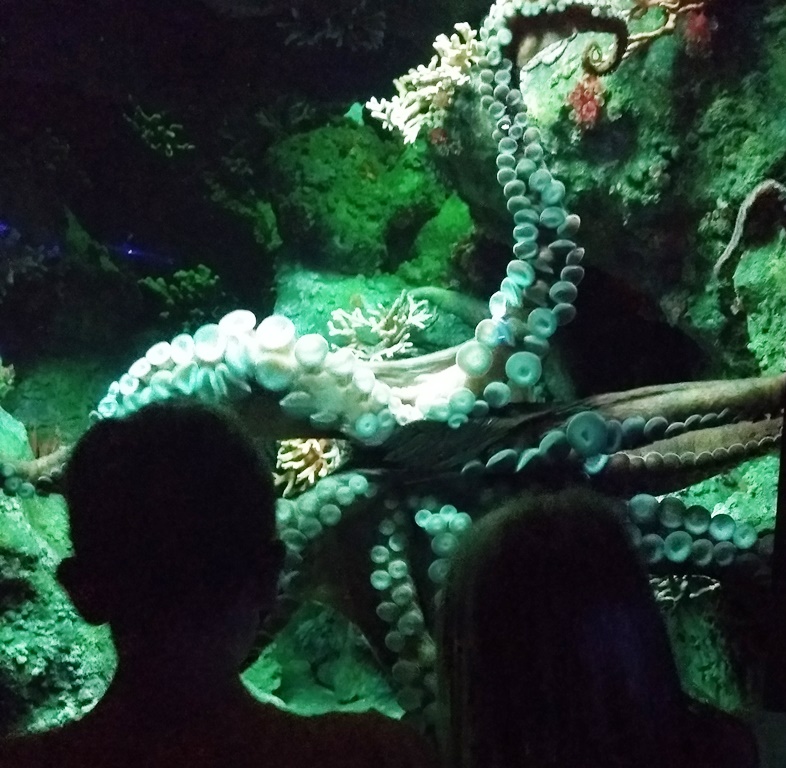
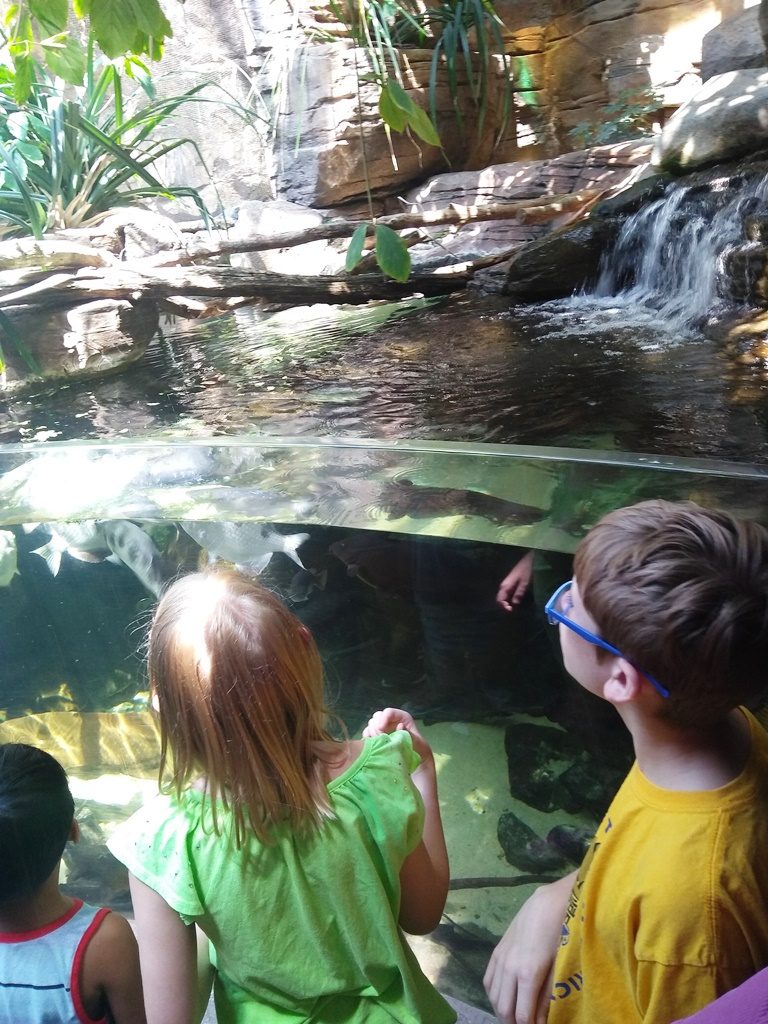
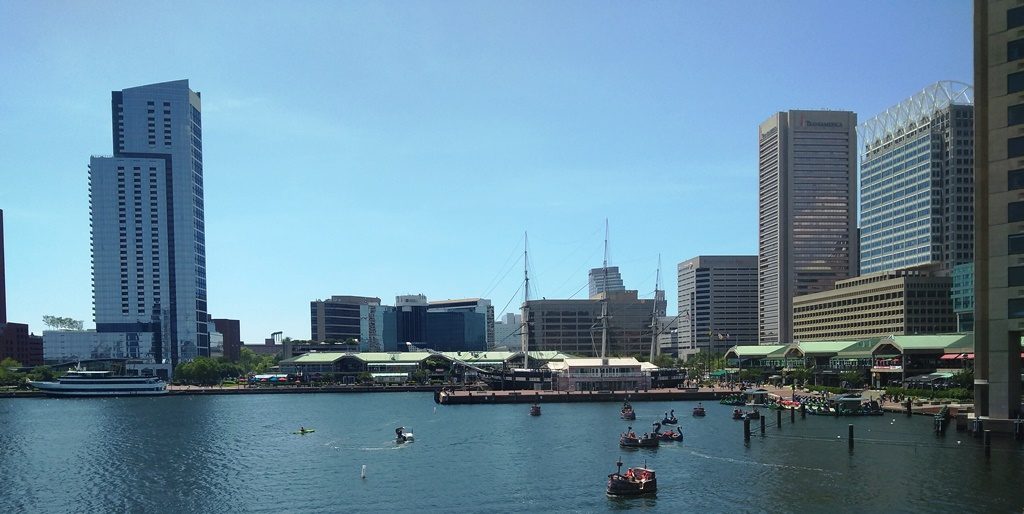







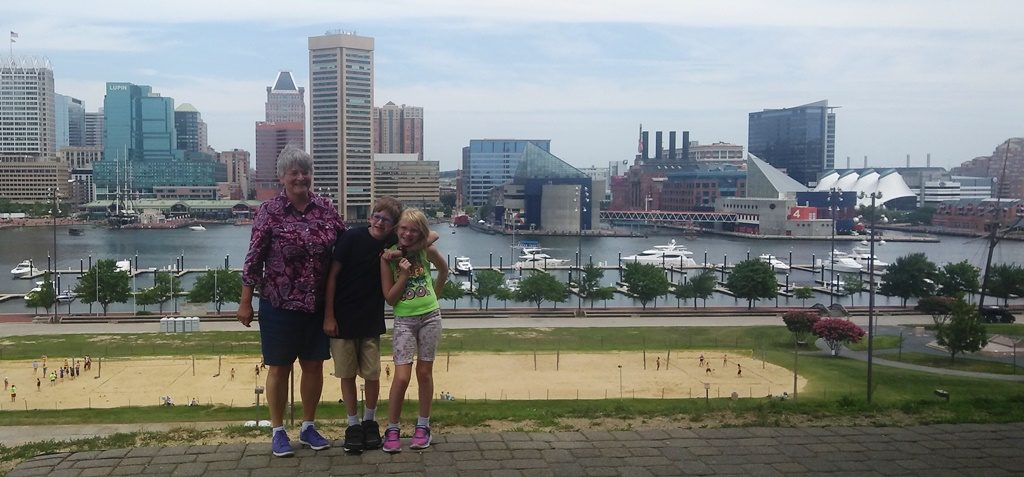
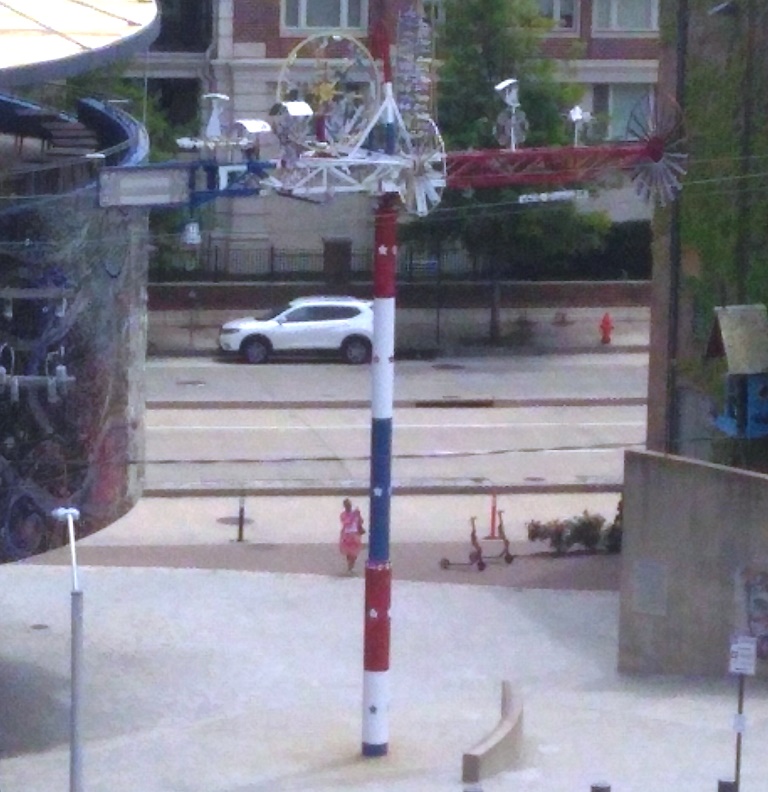
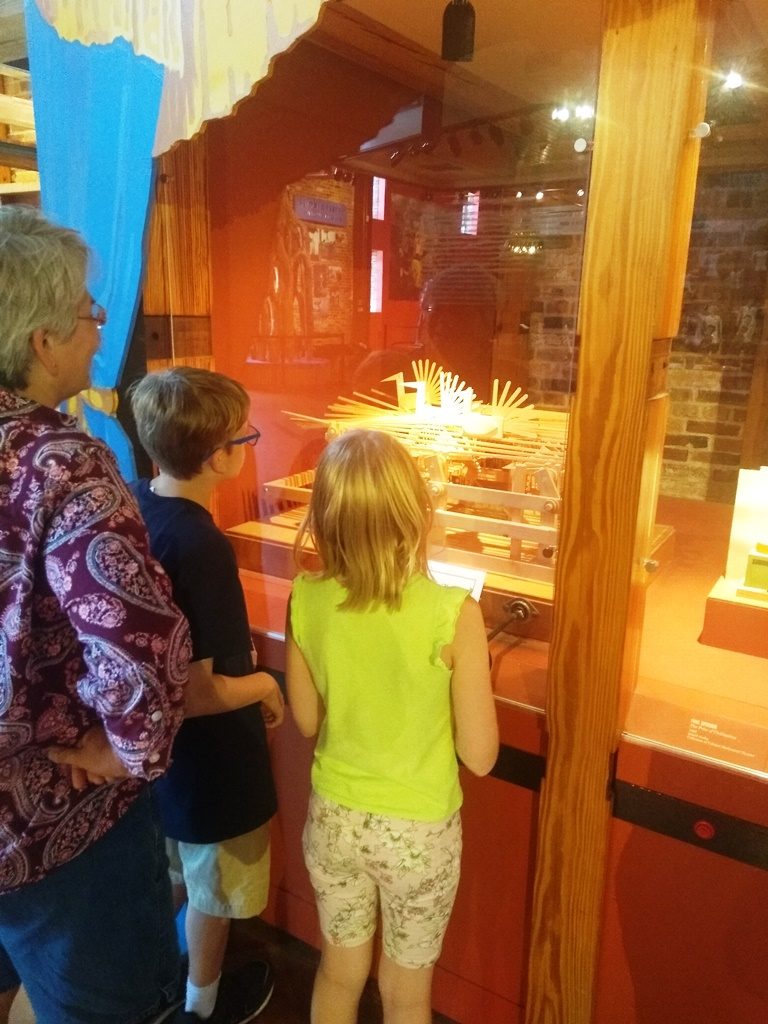
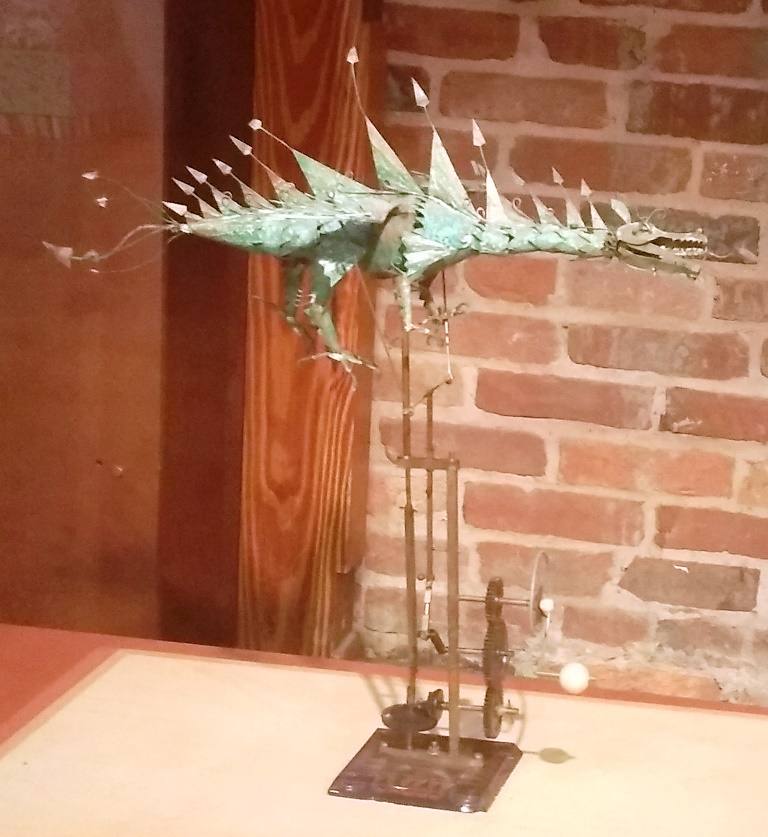
Danita has basically recovered from her pains. She has one last PT appointment in 2 weeks, and she’s still weaning off the Prednisone. Fortunately, she avoided the side affects some people experience on Prednisone. I’m still not sleeping well, but I’ve been able to take some shorter bike rides. I am starting my PT tomorrow. I got a very early 7 AM appointment so I won’t interfere with this week’s major activity, which is the grand kids. They’ll be arriving about 3:30 today. They will be with us all week. Last year a full week was a few days too much away from home. Jul is coming up Thursday to visit and escort the kids around DC. In the mean time, we’ve thrown the “adventure” rules out the door and allowed the kids to pick their activities from a list. We’ll be visiting the American Visionary Arts Museum Sunday, Aquarium Monday. Tuesday is a play day with Suzanne and Addie. We’ll wrap up the Baltimore activities Wednesday with a Pirate Cruise in Baltimore. We also have a stack of videos about 2 feet high, special meals, and more. We had a neighborhood party last night to help us get ready for our exciting week. We’ll have another neighborhood party Saturday to help us celebrate a fun week.
I’ve given two “classes” on cutting the cord. We have a small class, which is nice. One of the residents decided this was such a good idea that he should buy a new TV. His wife told my wife it is the most expensive free class they ever took. I’m not offering a class this week. Next week, the room isn’t available. We’ll finish up by talking about TV antennas and such the following week.
That’s it for us. I’ll probably be posting grand kid pics on the website this week, but I won’t send Emails. Some folks still have slow internet, and I’m too lazy to delete the photos. Feel free to visit the website this week. I hope this finds everybody doing well.
Danita’s doing great. I’m still recovering. I’m sleeping in a bed, but I wake up and move around a lot, so I’m upstairs for now. I had a strange experience in Church this morning. I experienced much more pain than normal. I’m thinking that was not a message from God. I feel much better now. It must have been my posture.
We had a neighborhood party this week, but we didn’t attend. It was free hot dogs at the pool July 4. Neither Danita nor I are interested in hot dogs, especially if there’s no fried onions and peppers for toppings. In addition, it there was a heavy rain. Those who were so desperate that they were willing to go were all huddled under the roof of the porch. That’s not our idea of fun.
Columbia had their normal fireworks show which I’m sure was spectacular. But there was still a pretty good chance of rain. So we stayed home, had some sangria, and watched a movie that was partially shot in Venice Italy.
Having skipped the party and fireworks, we decided to go the the Howard County summer theater yesterday. This is a group of amateurs that put on one production a year at one of the high schools. Without exaggeration, there had to be 100 people involved one way or another. We saw The Pajama Game, a 50s era book, play, and movie. Doris Day starred in the movie version. Sometimes life isn’t fair. Danita was sitting in an aisle seat. They had happy dancing girls coming down the aisle. After intermission, I asked Danita to swap with me. I had angry striking factory works coming down the aisle. NOT FAIR!
Mom is excited because her kitchen cabinets came in. They’ll be rebuilding her kitchen next week. Her bedroom is done but the master bath stalled, waiting for a plumbing inspection and permit.
I hope this finds everybody doing well.
We have really great news this week. Danita is feeling much better. Danita’s been out of the easy chair and sleeping in out bed for most of the week. The Prednisone did the trick. Her rheumatologist is already starting to taper her dose down. She’s still working on her range of motion, but most of that is at home. She’s cutting the PT down to once a week.
I had some bad news. Wednesday, I ran my bike off the edge of the road. It had a bit of a drop and I ended up splayed across a grass field. I was in the last quarter of one of my more challenging routes, rolling down hill and feeling good when it happened. Danita was taking her dad to a doctor, so I decided my best option was to ride home. I wimped out and took the easy, 5 mile route instead of the fun and challenging 10 mile route I had planned. The bike got a bent crank arm. I got bumps and bruises to my upper body. The doc patched me up with some butterfly bandages. I’m getting around pretty well, but it still hurts when I laugh. So Danita’s in our bed, but she’s sleeping alone because I’m downstairs in the easy chair. This recovery thing is a little slower now that I’m over 70.
We don’t have any neighborhood parties this weekend, so we plan to go to a play at Baltimore County Community College tomorrow. Tomorrow is a “5th Sunday”. We try to do a special breakfast. This week, we’re going to a Mexican restaurant on the other side of the tracks. This place is a real hoot. It’s a short drive to the prison and several truck stops. The shopping center it’s in is just a pawn shop short of perfection. But the prices are good and the food is great. We had dinner there one night and had a great time. I understand the place had even more atmosphere when it was located in the back of the gas station. Monday I’ll go back to see the doc. I’m healing up pretty well, so I expect to be thrown out with an admonition to stop doing foolish things. Monday evening I’m giving a neighborhood presentation about how one can save money by “cutting the cord”.
I hope this finds everybody doing well.
Danita is still feeling pains. The prednisone has helped, but it hasn’t been the miracle cure that it is for some patients with PMR.
Danita and I met her siblings at Bud’s place for a father’s day dinner last Sunday.
I had a very unusual event happen this week. Our shower door has been droopy. It got worse, and I called in some experts. They found that the door wasn’t properly reinforced. The entire 65 pound door was being held up by screws in wallboard.So the men drilled out the old plugs, installed new plugs as a temporary measure, and went to their next appointment. An hour or so later, there was a short in the bathroom. There is a switch for the closet light on the other side of the wall from where the men drilled. I figured they nicked the wire. I removed a piece of the wall and found the wire completely undisturbed.
But there was still the short. I removed the wiring from the switch. Still a short. How about the closet light fixture? No.I removed wiring from the bathroom fan. No joy. I tried the fixture over the vanity. Nope. Could the breaker be defective. I took the electric panel cover off and swapped breakers. The breaker works fine. There aren’t many possibilities left. There are 3 switches on the other side of the bathroom. I took the first one out, no problem found. When I took the middle one out, I saw the darnedest thing. There was a sliver of the hot wire exposed where it went into the switch. The safety ground wire was right next to it, and part of it had melted. That switch sat inside the wall for 10 years with no problems, then decided to short shortly after those guys drilled the wall on the opposite side of the bathroom.
Fixing the short was easy. But I still had a bunch of stuff torn apart, with parts on the floor and wires sticking out of walls. The light fixture over the vanity was so cheap I couldn’t reassemble it. But I got everything else put together. When I was done, the light fixture in the closet didn’t work. Danita and I went to Lowe’s and didn’t see anything we liked. So we went out for pizza. When we came home, I ordered the fixtures from Amazon. The closet fixture was a breeze to put up and worked perfectly. The vanity fixture was even better. It was the same size as the original fixture. You can’t see any of that ugly discolored drywall around the light. It was much better built and therefore much easier to install. The best feature was the drop cords that suspended the lamp near the base plate while I connected the wires with my “other two hands”. I finished the installation just in time so that Danita and I could go to a condo party. We had a food truck with pit-beef, pulled pork, and other foods of that ilk. The weather was perfect.
Everything in the bathroom is back in place, except for the bracing for the shower door. Unfortunately, the screws are right next to an existing stud, so I can’t just insert a 2×4, because the screws will be at the edge and won’t get a good bite on the wood. I have a workman lined up to help, but it’s a small job and I have to wait until he has time in his schedule.
Now we’re all set to attend the neighborhood concert Sunday, with snacks, desserts, and libations.
I hope this finds everybody doing well.
Danita is still suffering from her mystery pains, but things are starting to look up. She saw a rheumatologist who said she probably has PMR. That’s what I had some 20 years ago. The best way to diagnose PMR is that it responds very quickly to prednisone. Danita started her regimen Friday evening. Fingers crossed! She’s still doing her PT, mostly working on range of motion.
Our condo (Kendall 1) had some really great news. When the contractor built our houses, they installed some of the flashing upside down. This allowed water to leak into affected houses. The symptoms weren’t obvious for years. When the symptoms became obvious, it took time to figure out the cause, find an engineering company to do a study, and do a test repair on one unit. The condo sued the builder. The builder brought in the subcontractors and the architect. Then the builder merged with another company, and we started all over again. This has been going on for the last 3 ½ years. Residents who want to move out have been able to sell their houses, but it was tough. Most banks wouldn’t offer a mortgage. Most sales were cash deals. About a week ago, the board announced that they have settled the suit in arbitration and they are very satisfied with the deal. Residents don’t know what the deal is yet because the final papers are still being drawn up, but it’s obviously a multi-million deal. So far as I know, my unit isn’t affected. But the condo will be carefully inspecting all units to make sure. We haven’t even started planning the repairs. The general hope is that we can start construction next spring, with construction lasting about a year. After that, we’ll have to work on some sidewalk and street repairs we’ve been putting off. With heavy construction equipment moving in and out, those repairs are expected to grow. We have some residents with professional experience in the construction industry. We’ll be calling on their expertise as we move forward.
We’ve had some delightful weather. I got a nice set of rides. That’s good because it looks like it will be a rainy week coming up.
Danita’s been working on her retirement papers. She’s made good progress, but somehow the package sent by Raytheon got returned as undeliverable. I’ve been working on my minimum withdrawal from my IRA, which is with TRP (T. Rowe Price). It’s a slow go. I linked our savings account to my IRA funds. TRP had to do micro-transactions for verification. After the micro transactions, I didn’t receive the Email that told me what to do next. I went to their website to see if I could figure it out, and found their login system was down. I called customer service and they fixed me up. I’m all set to buy more funds from TRP, but I have to wait another week before I can move funds out. After that, I’ll be able to set up an automatic annual transfer. And after that, I’ll be able to set up charitable contributions directly from my IRA, so the donations don’t count as income. That last is important because the new tax laws are very unfavorable for Danita and me. My goal was to get all this done before July 1. It’s going to be close. Fortunately, there’s noting special about the July 1 date. It’s just a goal.
I hope this finds everybody doing well.
We had an entire week without tornadoes in Howard county, but we did have a severe storm with high winds. Trees were down all over the place. Roads were closed. 3000 people were without power. The only effect to us was an evening’s loss of internet. Within 2 days, the roads and power were restored. Columbia has over 100 miles of pedestrian trails. Our neighborhood is “land locked” by major roads. I use a couple of trails to break out when I ride. It was easy enough to walk around the downed trees. I figured it would be a week at least before the trails were clear. But they were clear by the third day. That surprised me.
The contractor said the construction on Mom’s house should start next week. Mom is looking forward to that.
Danita sees the doctor tomorrow. Until now, Danita has received treatment for her symptoms. She’s hoping that tomorrow will be the beginning of finding the cause.
I’m getting a crown Tuesday. Our dentist does the entire crown in one sitting. I go in at 9 AM and I’m home for lunch, complete with a permanent crown. (And a pretty hefty bill. But hey, that’s life.)
We had a neighborhood concert/pot luck dinner last night. We don’t have another party until Friday’s Grill & Chill (bad hamburgers and good neighbors).
Danita successfully applied for Medicare. That was harder than it sounds. She kept getting a message that she couldn’t be verified. She called the help line, and was told she had to un-freeze her credit report at Equifax. That should have been streight forward, but Equifax switched from a PIN verification to a password verification, and we weren’t able to get the switch-over to a password to work. Danita finally called Equifax to un-freeze her report. We’ll have to fix the password later. Danita is also also applying for her pension benefit at Raytheon and Honeywell.
We decided to pay for access to shows on cbs.com for the summer. They have several series that are not broadcast, and are available only online. Yesterday, Danita was watching Bonanza on ME TV and I wanted to watch Twilight Zone on cbs.com. There being only one TV, I decided to watch Twilight Zone on my computer. Somehow, I accidentally switched the TV to Roku mode. It was no big deal, but it sure surprised both of us.
I hope this finds everybody doing well.
Danita is still not doing very well. She is looking forward to her doctor appointment June 10. It seems like a long way to go.
We gave a “Lunch & Learn” presentation Thursday. Typically a resident will talk about their career. Danita and I decided to offer a joint presentation based on our experience as National Park Service volunteer rangers. It was a lot of fun. That evening we went to a BSO concert. We were surprised the musicians weren’t sitting on the stage playing around with their instruments. When the musicians filed in, many in the audience gave a standing ovation. We didn’t know this, but the BSO management had announced earlier in the day that the summer concert season is cancelled, the concert season is changed from 52 weeks to 40 weeks, and the musicians will not be paid for those 12 weeks. There was a lot of emotion in the audience. When we got out in the lobby, we checked for news articles on our phones. The BSO is over $16 million in debt. Maybe the management is taking a prudent step. Anyway, it was a good concert.

We’re not through talking about Thursday yet! After we got home, Howard County had their second tornado, exactly one week after their first tornado. Tornadoes are rare in this part of the country. Having one in the summer is unusual. This one was a little further to the west — about 15 miles from our house. Only a few buildings were damaged, with plenty of trees down and power outages.
I’m moving on to Friday, but it turns out I’m not quite through with the tornado. The weather Friday was gorgeous, so I decided to do an out-and back (same roads both ways) to that area. It’s a route I ride about once a week. The objective is to ride 20 miles to the Glenwood Library so I can eat a Royal Farms sub and a bag of chips, then return home. Riding out was fine. Coming back, the road was blocked because a tree fell on a car. Considering the traffic at that spot is typically one car every couple of minutes, that is a quite unusual event. I ended up taking a 30-minute detour to get around the road closure.
Moving on to today, I thought the aftereffects of the tornado would certainly be over, but I was wrong. It is another beautiful day. I did a ride to Ellicott City. This is another ride I do once or twice a week. The objective is to ride a circle route of about 20 miles total, taking many hills as possible, and see whether The Breadery has any chocolate-raspberry muffins. (They didn’t, I had to settle for a 3-cheese scone.) I had to take a walk in the woods to get to my scone. A tree had fallen earlier in the morning, taking a power line down and closing the street.
That’s plenty of excitement for one week. I hope this finds everybody doing well.
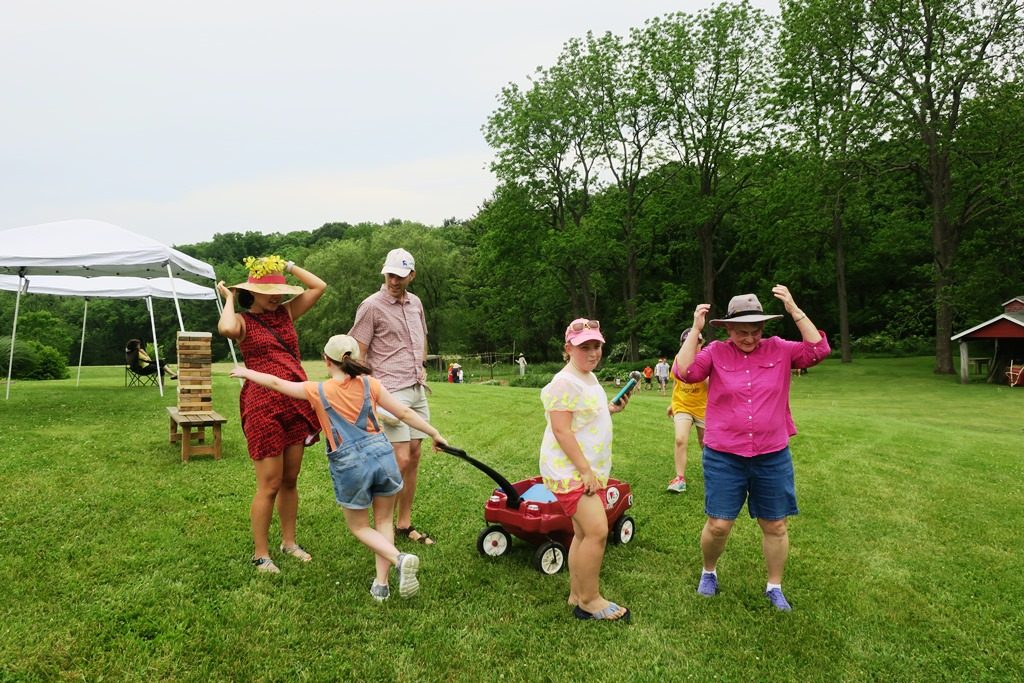
This being the Sunday before Memorial Day, it is the day of the Parkton Cup Invitational, and Danita and I have scored a coveted invitation! Mark and Jiajia are in town to prepare the US physics high-schoolers for the international physics competition and were able to spend the afternoon with us. Here’s a pic. There are some more on the website.
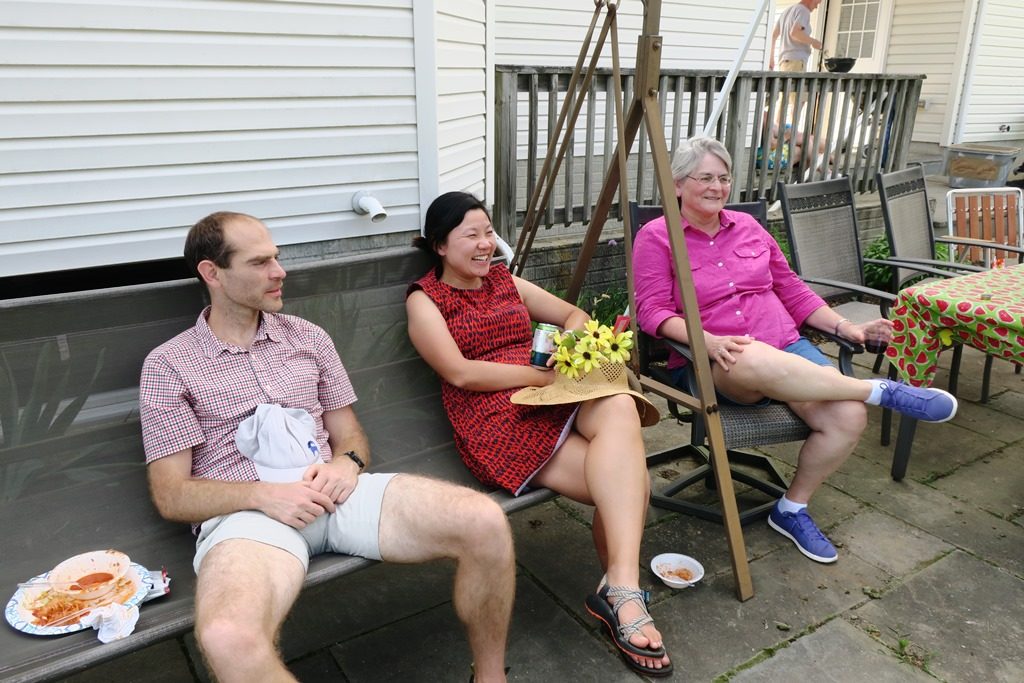
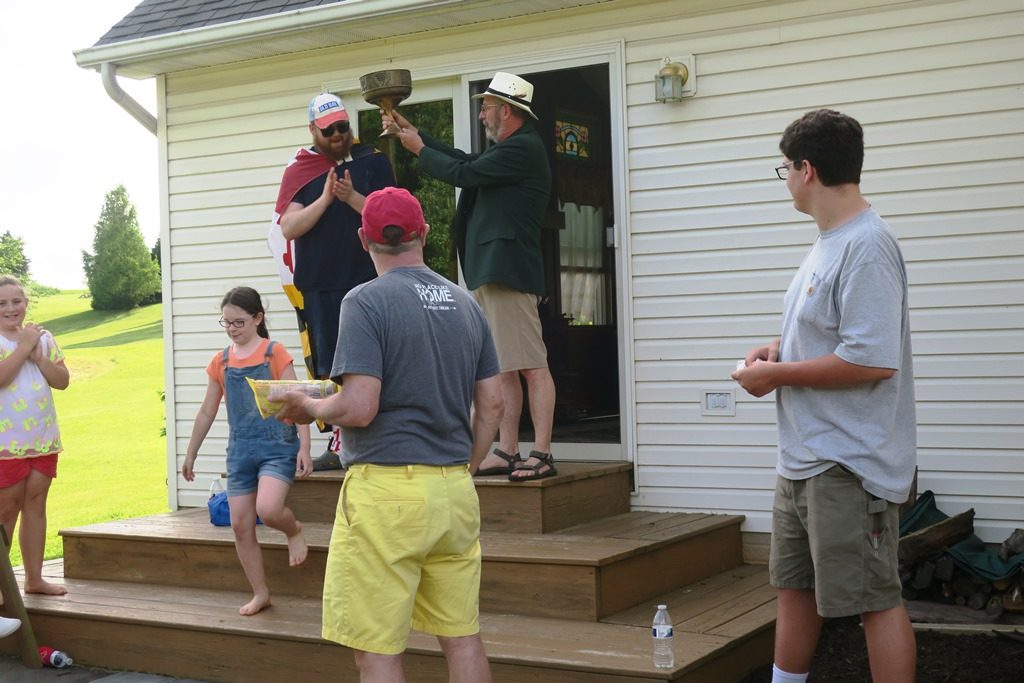
Danita is still experiencing her mysterious pains. She seems to be doing a little better. She’s able to do most of the things she normally does. Her next doctor appointment is in two weeks.
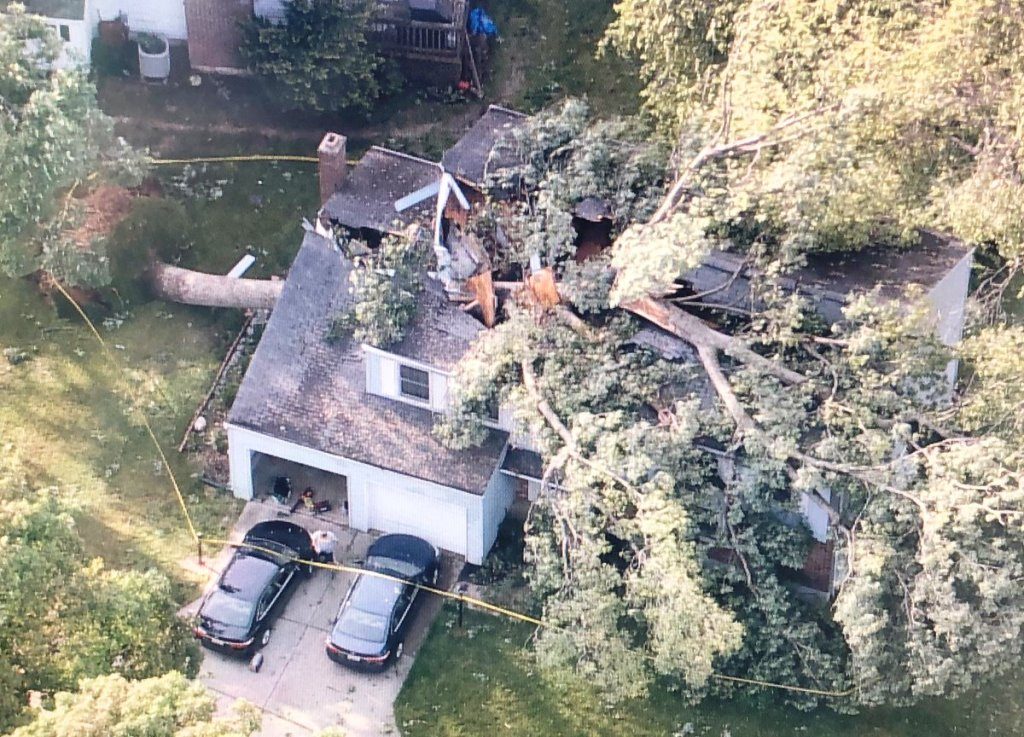
The big news in Columbia is the tornado that struck last week. It touched down in Clarksville and followed Rte 32 to Columbia, a distance of about 10 miles. There were trees and branches down all over the area. Some very dramatic damage occurred within 5 miles of us. If you go to the website, you will see a picture of the tornado cloud near the Columbia Mall, and a picture of a tree that cut through a house like a knife through butter. Fortunately, there was only one injury, which was not life threatening. You can see some interesting pics on the website.

After all the bike riding I’ve done, I thought I had seen it all. But I had three special challenges this week. The first was a machine that created huge clouds of dust. It was supposed to be a street cleaner, but in this case it was only creating dust. It drove slower than a bike, but not slow enough for me to pass. So I just hung back and endured the dust as best I could. The second was a squirrel. Squirrels can be quite dangerous to bikers. They can get caught up in the spokes of a wheel, spin around, and hit the fork. When that happens the spokes experience a sudden force in a direction they are not designed to handle. The end result is a ruined wheel and an immediate transition from vertical to horizontal for the cyclist. Squirrels are nothing new for me, but this one was at the entrance to an intersection. There was a lot of “interesting” traffic absorbing my attention. When I finally noticed the squirrel at the last moment, it seemed to me it was running much slower than squirrels normally run. Fortunately it was just fast enough to prevent a close encounter of the first kind. The third and most distressing unusual encounter was a tractor in a field. (Yes, there are farms in western Howard County.) Normally this is not a problem, but in this case, the tractor was upwind. And it had a huge tank filled with an unknown liquid with a large boom on the back spraying the field, and everything else that was downwind. One spot on the boom was leaking an evil-looking foam, like some strange rabid monster foaming at the mouth. The farmer was well separated from the spray. I was riding up hill. Going faster to pass sooner was no more of an option than holding my breath. It was a tough week for biking!
I hope everybody has an excellent Memorial Day holiday.